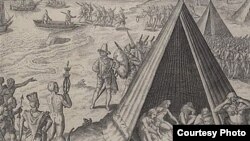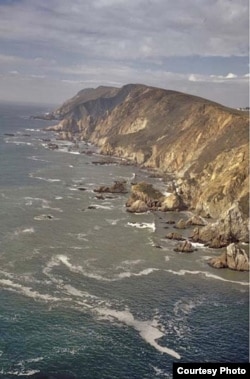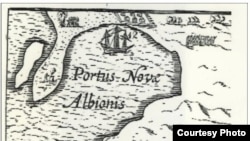The U.S. National Park Service is about to convey landmark status upon a place on the California coast, not far from San Francisco’s famous Golden Gate Bridge.
That sounds kind of routine, but some people up the coast in Oregon are not at all happy about it.
Sir Francis Drake, the daring British explorer, is said to have sailed to that little piece of California’s Pacific coastline 433 years ago, in 1579, in the middle of his epic three-year expedition around the world.
He mapped a cove where he landed - and named it and the surrounding cliffs “New Albion.” Albion, which is Greek for “white,” was an early name for Britain, inspired by the famous white cliffs near Dover.
Today, the California cove and bay are called “Drake’s Bay” in the explorer’s honor.
Drake is said to have hung around for five weeks, repairing his ships and interacting with Native American tribes. That’s the main reason the place is historic, for this was the first recorded contact between the British and American Indians.
So why should people up the coast in Oregon be upset?
They say Drake’s “Albion” visit didn’t happen there at all, that he actually put ashore farther north on the rocky Pacific coast.
Amateur historian Gary Gitzen and other Oregonians say that first contact took place in and around Oregon’s Nehalem Bay.
If you lay Drake’s own map of the cove he visited atop a map of Nehalem Bay, Gitzen says, “it’s the same outline.” He’s writing a book, called "Oregon’s Stolen History," all about it.
The National Park Service sent the conflicting claims to a couple of historic commissions, which ruled in California’s favor.
According to the Northwest News Network, the California location’s landmark designation will be a “done deal” as soon as U.S. Interior Secretary Ken Salazar signs the proclamation.
For now maybe, say the folks up north. They’re not about to give up their claim that the real Drake’s Bay should be in Oregon.
That sounds kind of routine, but some people up the coast in Oregon are not at all happy about it.
Sir Francis Drake, the daring British explorer, is said to have sailed to that little piece of California’s Pacific coastline 433 years ago, in 1579, in the middle of his epic three-year expedition around the world.
He mapped a cove where he landed - and named it and the surrounding cliffs “New Albion.” Albion, which is Greek for “white,” was an early name for Britain, inspired by the famous white cliffs near Dover.
Today, the California cove and bay are called “Drake’s Bay” in the explorer’s honor.
Drake is said to have hung around for five weeks, repairing his ships and interacting with Native American tribes. That’s the main reason the place is historic, for this was the first recorded contact between the British and American Indians.
So why should people up the coast in Oregon be upset?
They say Drake’s “Albion” visit didn’t happen there at all, that he actually put ashore farther north on the rocky Pacific coast.
Amateur historian Gary Gitzen and other Oregonians say that first contact took place in and around Oregon’s Nehalem Bay.
If you lay Drake’s own map of the cove he visited atop a map of Nehalem Bay, Gitzen says, “it’s the same outline.” He’s writing a book, called "Oregon’s Stolen History," all about it.
The National Park Service sent the conflicting claims to a couple of historic commissions, which ruled in California’s favor.
According to the Northwest News Network, the California location’s landmark designation will be a “done deal” as soon as U.S. Interior Secretary Ken Salazar signs the proclamation.
For now maybe, say the folks up north. They’re not about to give up their claim that the real Drake’s Bay should be in Oregon.







